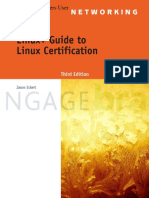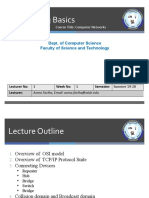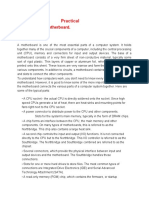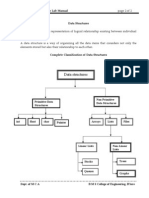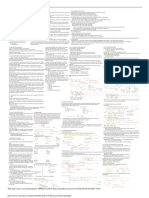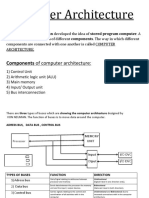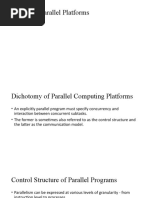0 ratings0% found this document useful (0 votes)
153 views7 Operating System
This document provides information about an upcoming lesson on operating systems. It outlines the specific objectives and materials needed for the lesson. The lesson will cover what an operating system is, its components, functions, and types. It will discuss the shell and kernel as the two main internal components of an operating system. Example operating systems that will be covered include DOS, Windows, Unix, Linux and Mac OS.
Uploaded by
BillyFrenzelCopyright
© © All Rights Reserved
Available Formats
Download as PDF, TXT or read online on Scribd
0 ratings0% found this document useful (0 votes)
153 views7 Operating System
This document provides information about an upcoming lesson on operating systems. It outlines the specific objectives and materials needed for the lesson. The lesson will cover what an operating system is, its components, functions, and types. It will discuss the shell and kernel as the two main internal components of an operating system. Example operating systems that will be covered include DOS, Windows, Unix, Linux and Mac OS.
Uploaded by
BillyFrenzelCopyright
© © All Rights Reserved
Available Formats
Download as PDF, TXT or read online on Scribd
You are on page 1/ 15
Installing Computer Systems and Networks
Operating System *Property of STI
Page 1 of 15
TOPIC TITLE: OPERATING SYSTEM
SPECIFIC OBJECTIVES:
At the end of the topic session, the students are expected to:
Cognitive:
1. Explain what an operating system is
2. Identify the components of operating system
3. Explain the different functions of the operating system
4. Identify the types of operating system
Affective:
1. Listen to others with respect
2. Participate in class discussions actively
MATERIALS/EQUIPMENT:
1. topic slides
2. OHP
TOPIC PREPARATION:
Have the students research the following:
Definition of operating system
Different types of operating system
Components of operating system
Functions of operating system
Boot Process
Online Reference:
http://www.howstuffworks.com
TOPIC PRESENTATION:
The topic will revolve around operating system. Discussions
will include operating system (OS) components, OS operation,
OS functions and types of OS.
Guide Questions:
1. What is an operating system?
2. Explain briefly the components of OS.
3. What are the functions of OS?
This will be the suggested flow of discussion for Operating
System.
1. Explain what an operating system (OS) is.
2. Discuss the different components of an OS.
3. Discuss the operation of an OS.
4. Identify the types of OS.
Show the slides with captured screenshots and explain
them to the class.
5. Explain the different functions of an OS.
Installing Computer Systems and Networks
Operating System *Property of STI
Page 2 of 15
Computer Software
Page 1 of 17
PC Technology 1
* Property of STI
Page 1 of 17
Operating System
Computer Software
a program or set of instructions that tells
the computer what to do
System software
programs that control the basic
operations of a computer system
Application software
programs that are used to
accomplish specific tasks for
computer users
Computer Software
Note to the instructor: Ask the students to define what a
computer software (or simply software) is.
Computer software is a program or set of instructions that
tells the computer what to do. It enables computer hardware
to perform specific tasks. If the processor is the brain of the
computer, then the software is what the computer thinks
(www.pcguide.com).
There are two classes of software: system software and
application software. System software are programs that
control the basic operations of a computer system such as
saving files, printing files, accepting input from keyboard, and
others. It helps run the computer hardware and computer
system. System software includes operating systems, device
drivers, utilities, and more. Application softwares, on the other
hand, are computer programs that are used to accomplish
specific tasks for computer users. Examples of application
software are word processors, spreadsheets, presentations,
database management software, games, and others.
The succeeding discussions focus on computer operating
systems.
[Computer Software, Page 1 of 17]
Operating System
Page 2 of 17
PC Technology 1
* Property of STI
Page 2 of 17
Operating System
Operating System (OS)
software that contains instructions that
coordinate all the activities among
computer resources
serves as the middleman between
applications and hardware
Operating System
Note to the instructor: Before presenting the slide, ask the
students first to share what they have read about Operating
System. Call on 2 to 3 students to give the definition of
Operating System.
An operating system is a system software that manages the
hardware (such as processor, memory, hard disk, etc.) and
software resources of the computer system. It also provides
interface for users to store, retrieve, and manipulate files. For
example, operating systems recognize input from the
keyboard, keep track of files on the hard disk and control disk
drives. In general, an OS acts as an intermediary between
software and hardware. General-purpose computers must
have an operating system installed to run other programs and
to allow a user to interact with the computer.
[Operating System, Page 2 of 17]
OS Components
An operating system can be divided into two parts: shell and
kernel. The figure below shows the relationship between the
user, the shell, and the kernel. As seen in the figure, the shell
is the outer layer while the kernel is the innermost part of the
operating system, hence the terms shell and kernel.
Installing Computer Systems and Networks
Operating System *Property of STI
Page 3 of 15
OS Components
Page 3 of 17
PC Technology 1
* Property of STI
Page 3 of 17
Operating System
OS Components
Every operating system has two main
internal components:
Shell
relates to the user and to applications
Kernel
core of an operating system
Shell
Kernel Operating System
Computer User
user makes a request to the
operating system through the shell
shell checks
users request for
validity and
correctness and
then passes it to
the kernel
kernel performs
requested service
Shell
Kernel
Operating System
Computer User
user makes a request to the
operating system through the shell
shell checks
users request for
validity and
correctness and
then passes it to
the kernel
kernel performs
requested service
The shell is the portion of the OS that relates to the user and
to applications. That is, in general, it is the shell that the user
and applications interact with. It works with the operating
system as a command processor, used to enter commands,
and initiate the execution. Running applications actually form
another layer around the shell so that the user interacts with
the application to perform specific (more complicated) tasks.
The kernel is the core of an operating system. This part loads
when you first turn on your computer. The kernel controls the
computer hardware and performs the basic or low-level
services being offered by the operating system. It stays in the
memory while the computer is running to help manage
memory, maintain the computer clock, start applications and
assign resources such as devices, programs, data and
information.
The kernel is considered to be memory resident because it
stays in memory while the computer is running. However,
other parts of the operating system may be nonresident and
are stored in secondary storage (typically on the hard disk)
until they are needed.
[OS Components, Page 3 of 17]
Sample Operating
Systems
Page 4 of 17
PC Technology 1
* Property of STI
Page 4 of 17
Operating System
Sample Operating
Systems
Each operating system is designed to
support different types of hardware
systems and user needs.
Disk Operating System (DOS)
Windows
Unix
Linux
Mac OS
Sample Operating Systems
Several operating systems are available today. Among those
popular (or used to be) for personal computing are DOS,
Windows, Mac OS, Unix, Linux and OS/2. Each operating
system is designed to support different types of hardware
systems and user needs. The OS links the various elements
of the computer system together through common hardware
interface, a common programming interface and a common
user interface.
[Sample Operating Systems, Page 4 of 17]
Installing Computer Systems and Networks
Operating System *Property of STI
Page 4 of 15
DOS
Page 5 of 17
PC Technology 1
* Property of STI
Page 5 of 17
Operating System
Disk Operating System
(DOS)
It is the first OS used for IBM and IBM-
compatible computers.
It uses a command-line interface where
the user has to enter specific commands.
C:\>dir
Volume in drive C is MS-DOS 6_0
Volume Serial Number is 446B-2781
Directory of C:\
COMMAND COM 52925 03-10-93 6:00a
1 file(s) 52925 bytes
10219520 bytes free
C:\>ver
MS-DOS Version 6.00
C:\>
DOS
Early operating systems were designed simply to control how
you read from, write to files and disks, and were hence termed
basic disk operating system or BDOS.
The original operating system that came with the IBM PC was
called PC-DOS developed by Microsoft. In this case, DOS
referred to the operating system being resident on a disk. By
some loophole in the license agreement between Microsoft
and IBM, Microsoft was able to market a better version of PC-
DOS called the MS-DOS (Microsoft DOS) which quickly
surpassed PC-DOS in popularity. At present, DOS is used to
refer to both PC-DOS and MS-DOS in general.
Below is a screenshot of an MS-DOS 6.0 session. DOS uses
a command-line interface where the user has to enter or type
specific commands at a system prompt (C:\> in this case).
The example shows the execution of the commands dir and
ver. The first lists the contents of the currently selected disk
(drive C: as indicated by the prompt) while the second shows
the version of MS-DOS loaded. The last line shows the
prompt while waiting for user input.
DOS is no longer popularly used in lieu of OSs that use the
more user-friendly graphical user interfaces such as Microsoft
Windows. However, most Windows OS continue to support
DOS to allow users to execute commands and complete
specific tasks. In most cases, these are commands that allow
finer control over the operating system and/or would be too
dangerous to be at easy access of non-advanced users.
[DOS, Page 5 of 17]
Installing Computer Systems and Networks
Operating System *Property of STI
Page 5 of 15
UNIX
Page 6 of 17
PC Technology 1
* Property of STI
Page 6 of 17
Operating System
Unix
It is a popular OS used to manage
networks, support multiple users, to handle
a high volume of instruction and to support
applications used on the Internet.
It is an open source OS.
Below is a screenshot of a sample UNIX
command prompt.
[piferr@neverland piferr]$ whoami
piferr
[piferr@neverland piferr]$ ls
public_html stuff
[piferr@neverland piferr]$ date
Wed Jul 14 15:50:41 EDT 2007
[piferr@neverland piferr]$
UNIX
Originally written on a 16-bit PDP-7 minicomputer, Unix was
designed to be a time-sharing and multi-user system. These
capabilities used to be exclusive to the larger mainframe
computers. Most major hardware platforms have a proprietary
OS derived from Unix such as the AIX for IBM computers and
Solaris for Sun Microsystem. It and its derivatives have
become the preferred OS among many computer
professionals (hackers) and scientists due to system
efficiency, stability, and security. (Trivia: The internet and the
web were designed according to Unix requirements. Hence,
Unix and its derivatives are considered native to the internet
and web.)
Below is a screenshot of a sample Unix command-line
session. This shows the prompt and the execution of three
commands: whoami which identifies the current user, ls
which displays the contents of the current directory, and date
which shows the current system date and time.
Current versions include a graphical user interface capability.
[UNIX, Page 6 of 17]
Linux
Page 7 of 17
Linux
Linux is a scaled-down version of Unix that was designed to
provide a low-cost but efficient and secure operating system
for personal computer users. The Open Source status of
Linux along with its reputation for reliability, robustness and
fast-performing system has made it popular. Various
versions or packages of Linux, called distros (from
distribution), exist, including Bayanihan Linux, a distro
designed for the Philippines. Linux is also available in
commercial versions such as Red Hat, LindowsOS,
Slackware, SuSE and others. Below is the famous Linux logo.
[Linux, Page 7 of 17]
Installing Computer Systems and Networks
Operating System *Property of STI
Page 6 of 15
Mac OS
Page 8 of 17
Mac OS
Mac OS is available only for Apple Macintosh computers. The
Mac OS has long been the model for ease of use and good
user interface design. Newer versions also provide features
such as built-in networking support and strong multimedia
capabilities. Macintosh computers often are used by people
working with graphics applications, by students in educational
settings and by home users. Below is the Mac OS logo.
[Mac OS, Page 8 of 17]
Windows
Page 9 of 17
PC Technology 1
* Property of STI
Page 8 of 14
Operating System
Windows
The Windows operating system is the
operating system most widely used on
todays personal computers.
Each Windows version developed was
designed to provide additional features for
specific users including home or business
users.
Windows 9x logo
Windows XP,
2003 Server and
Vista logo
Windows
The Windows operating system is the operating system most
widely used on todays personal computers. Microsoft has
developed many versions of the Windows operating systems
over the past few decades. Each version was designed to
provide additional features for specific users including home
and business users. (Windows Vista is the most recent
version of Windows as of 2007).
[Windows, Page 9 of 17]
Windows Version
Page 10 of 17
PC Technology 1
* Property of STI
Page 10 of 17
Operating System
Windows Versions
It combines the strength of Windows 2000 with
the user-friendly features of Windows 98 and
Windows ME.
Windows
XP
It is a network operating system with additional
features for managing and maintaining a
network.
Windows
Server
2003
It is the most recent version of Windows as of
2007. It has updated graphical user interface,
advanced multimedia and improved security.
Windows
Vista
An upgrade of Windows NT. It has several
versions such as Windows 2000 Professional,
Windows 2000 Server, Windows 2000
Advanced Server and Windows 2000
Datacenter Server.
Windows
2000
It comes in two versions: Windows NT
Workstation and Windows NT Server. It is
used for businesses and technical users.
Windows
NT
It includes the Windows 95, Windows 98 and
Windows ME (Millennium Edition). Windows
9x rely on a DOS core.
Windows 9x
Early Windows version including Windows 3.1
and 3.11. It uses the DOS system.
Windows 3x
Description Windows
Version
Windows Versions
Windows
Version
Description
Windows 3x Early Windows version including Windows 3.1
and 3.11. It uses the DOS system with a GUI
that runs on top.
Windows 9x It includes the Windows 95, Windows 98, and
Windows ME (Millennium Edition). Windows
9x rely on a DOS core.
Windows NT It comes in two versions: Windows NT
Workstation is used for technical users and
Windows NT Server is used for business.
Installing Computer Systems and Networks
Operating System *Property of STI
Page 7 of 15
Windows
2000
An upgrade of Windows NT. It has several
versions such as Windows 2000 Professional,
Windows 2000 Server, Windows 2000
Advanced Server and Windows 2000
Datacenter Server.
Windows XP It combines the strength of Windows 2000 with
the user-friendly features of Windows 98 and
Windows ME.
Windows
Server 2003
It is a network operating system with additional
features for managing and maintaining a
network.
Windows
Vista
It is the most recent version of Windows as of
2007. It has updated graphical user interface,
advanced multimedia, and improved security.
The table above shows the various versions of the Windows
operating system. The Windows 3x provided a graphical user
interface to what essentially still a DOS system. The Windows
9x versions are true operating systems unlike Windows 3x
operating environment. The Windows 9x rely on a DOS core
while providing a user-friendly interface and advanced
features such as Plug and Play (PnP), more integrated
Internet capabilities and support for hardware devices such as
DVS. (Optional: Plug and Play is a standard designed to
make installation of hardware devices easier allowing the
connection of a device to a computer. After which the
operating system recognizes that hardware has been changed
since the last time the computer was started or while the
computer was running. A server is a computer that controls
access to the hardware, software and other resources on a
network and provides a centralized storage area for programs,
data and information.) The Windows NT version on the other
hand contains more advanced security features, network
support and user administration features. The Windows 2000
version is more of a network operating system, which provides
additional features such as network support and increased
stability. Windows XP provides an upgraded user interface,
support for multiple users, better performance to help
programs run faster and more support for multimedia such as
audio and video. Windows Server 2003 provides increased
security, enhanced file and print server support for remote
access and more. Windows Vista is the most recent version
of Windows as of 2007. It has updated graphical user
interface, advanced multimedia and improved security.
Note to the instructor: Research on the features of Windows
Vista and discuss this on class. Encourage the students to
share what they know about Windows Vista.
[Windows Version, Page 10 of 17]
OS Functions
Regardless of the specific type of operating system, the OS
performs key functions such as providing a user interface,
managing files and folders, running applications and
Installing Computer Systems and Networks
Operating System *Property of STI
Page 8 of 15
OS Functions
Page 11 of 17
PC Technology 1
* Property of STI
Page 11 of 17
Operating System
OS Functions
OS provides a user interface
OS manages files and folders
Command-line
interface
Menu-driven interface Graphical user interface
managing hardware.
OS Provides a User Interface
When a PC first is turned on, the operating system is loaded.
After the OS is in control, it either automatically executes a
program or waits for its next instruction from a user. If you are
working with the OS, you see an interface on the monitor
screen. This interface can be a command-line interface, a
menu-driven interface or a graphical user interface.
Command-line interfaces With this, you type
commands or press specific keys to enter data and
command to instruct the OS to perform operations.
When working with a command-line interface such as
DOS, the set of commands entered which provides
instructions is called command language. Network
administrators and other users familiar with these
commands use a command-line interface to configure
devices, manage system resources and troubleshoot
network connections.
Menu-driven interfaces It provides menus such as a
way to enter data and commands. Menu-driven
interfaces are easier to learn than command-line
interfaces because users do not have to learn the
command language used to enter commands.
Instead, they just have to select functions from a
menu.
Installing Computer Systems and Networks
Operating System *Property of STI
Page 9 of 15
Graphical user interfaces Most of todays operating
system use a graphical user interface (GUI). With
GUI, you issue commands by selecting icons, buttons,
windows or other graphical objects on screen. When
an operating system is started, the initial screen
appears with menus, commands and icons. This is
called the desktop (in allusion to the work area of the
user).
OS Manages Files and Folders
An operating system is responsible for storing and organizing
files on a secondary storage medium such as a CD-ROM,
floppy disk or hard disk. Before any files can be stored on a
disk, the disk must be formatted. The process of formatting a
disk or partition places a file system on the drive. An
operating system relies on an organizational method called a
file system to use the space available on a disk to store and
retrieve files and to store information about the disks directory
or folder structure. The folder structure is defined during the
formatting process.
[OS Functions, Page 11 of 17]
OS Manages Applications
An operating system is responsible for managing all other
software on the PC including installing and running
applications. An application depends on an OS to provide
access to hardware resources, manage its data in memory
and in secondary storage and perform any background tasks.
For example, consider a situation in which Windows XP loads
and executes an application. The application cannot run or
even load itself without Windows XP, much as a document
cannot be edited without a word processing program.
Windows XP stays available to the application for the entire
time the application is running.
Installing Computer Systems and Networks
Operating System *Property of STI
Page 10 of 15
OS Functions
Pages 12 to 14 of 17
Installing and loading application software.
Application software typically is distributed on DVD-
ROMs, CD-ROMS, or floppy disks or can be
downloaded from the Internet. Because application
software usually must be installed on a hard drive in
order to run, application software comes with an install
or setup program that installs the software to a hard
drive. During installation, the install program creates
folders on the hard drive and copies files to them. For
Windows, the software installation process makes
entries in the Windows registry, in addition to placing
icons on the desktop and adding entries to the Start
menu. Once an application is installed, an operating
system provides a way to execute or load software.
Windows XP provides four ways to load software for
example the MS Word as shown in the figures below.
A. Using a Shortcut double-click shortcut on a
desktop
B. Using the Start Menu click Start button on
Windows taskbar, select All Programs and then
click program name.
Installing Computer Systems and Networks
Operating System *Property of STI
Page 11 of 15
C. Using the Command Prompt click Start button,
click Run or Start menu, and then enter a
command line or click browse to search for a
program file to execute.
D. Using the Windows Explorer
Handling Multiple Programs
Some operating systems only allow one program to
run at a time, while others allow multiple programs to
run at once. A single tasking operating system allows
only one program to run at a time. For example, if you
were working on a spreadsheet and then wanted to
check your e-mail, you would have to close the
spreadsheet program before starting the e-mail
program. DOS, which was used on older PCs, is a
single tasking operating system. Today, PDAs and
other small computing devices use single tasking
operating systems while most PCs use a multitasking
operating system. A multitasking operating system
allows you to work with two or more programs that
reside in memory at the same time. With a
multitasking operating system, you could leave the
spreadsheet program running while you launch your
e-mail program.
[OS Functions, Pages 12 to 14 of 17]
Installing Computer Systems and Networks
Operating System *Property of STI
Page 12 of 15
OS Functions
Page 15 of 17
PC Technology 1
* Property of STI
Page 14 of 14
Operating System
OS Functions
OS manages hardware An OS also is
responsible for communicating with
hardware.
OS uses device drivers
OS uses system BIOS to manage
devices
How an OS uses device drivers
Device drivers are small programs stored on the hard
drive that tell the computer how to communicate with
a specific device such as a printer, network card, or
modem. Device drivers are software designed to
interface with specific hardware devices. For
example, a printer driver translates the commands
sent by the printer to something more understandable
by the operating system. A device driver is installed
when the OS first is installed or when new hardware is
added to the system. An OS provides some device
drivers. The manufacturer of a specific hardware
device also usually provides device drivers with the
hardware device. In either case, unlike BIOS, device
drivers usually are written for a particular OS.
Installing a device in a system that supports Plug and
Play usually is a simple process. Plug and Play (PnP)
is a standard designed to make installation of
hardware devices easier. PnP applies to the OS, the
system BIOS, and the hardware devices themselves.
With PnP, if you connect a device to your computer,
the OS recognizes that hardware has been changed
since the last time the computer was started or while
the computer was running. Fox example, if you
connect a printer to a computer running Windows XP,
the OS recognizes the device, determines the system
resources needed by each device, and assigns
hardware resources appropriately. Windows then
determines which drivers are required to support each
device and load those drivers. Of all the Windows
versions, only Windows 3x and Windows NT do not
support PnP.
How an OS uses system BIOS to manage devices.
The basic input/output system (BIOS) on the
motherboard is stored on the ROM BIOS chip. The
data and instructions stored on the ROM BIOS chip
include the system BIOS, startup BIOS and the
CMOS BIOS or CMOS setup. The OS communicates
with simple devices such as floppy drives or
keyboards, through the system BIOS. In addition, the
system BIOS is used to access the hard drive. The
system BIOS uses the information in CMOS setup to
modify or supplement its default programming as
needed.
[OS Functions, Page 15 of 17]
Installing Computer Systems and Networks
Operating System *Property of STI
Page 13 of 15
Booting Up Your
Computer
Page 16 of 17
Booting Up Your Computer
Before an operating system can perform its functions or
communicate using the system resources, it must be loaded
from disk to main memory when the computer starts. The
process of starting or restarting a computer and loading the
operating system is referred to as the boot process or booting.
(Trivia: The original term used is bootstrapping in allusion to
lifting ones self by the bootstraps when putting on boots. The
process involves a small program built into the PC that loads a
small loading module from the secondary storage device.
This, in turn, loads the remainder of the OS and then transfers
control over to it.)
Booting refers to either cold boot or warm boot. A cold boot or
hard boot is turning on the computer that is powered off
completely. Hence, the operating system is initialized from
scratch. It involves turning on the computer with the on/off
power button.
On the other hand, a warm boot or soft boot is the process of
restarting a computer that already is powered on. A warm
boot re-initializes only parts of the operating system, and
under the control of the running operating system. With
Windows XP, warm boot can be performed by clicking the
Start button, clicking Turn Off Computer and then clicking
Restart as shown in the figure below.
Clicking the Restart button performs a warm boot.
If there is a need to reboot the computer, for example, when
the system freezes up, always try using the warm boot first. A
cold boot is more stressful on the machine than a warm boot
because of the initial power surge through the equipment.
Besides, a warm boot is also faster since fewer initializations
are performed. If the warm boot method does not work, the
cold boot method is performed instead using the on/off button.
Avoid turning the computer off and then immediately back on
without a pause because this can damage the machine.
[Booting Up Your Computer, Page 16 of 17]
Installing Computer Systems and Networks
Operating System *Property of STI
Page 14 of 15
Boot Process
Page 17 of 17
Boot Process
The functions performed during the boot can be divided into
four parts. Startup BIOS is in control for the first step and the
beginning of the second step, when control is turned over to
the OS.
1. Startup BIOS runs a process called the power-on self test
(POST) and assigns system resources.
The ROM BIOS startup program performs a POST, which
involves surveying hardware resources and needs, and
assigning system resources to meet those needs. The
ROM BIOS startup program begins the startup process by
reading configuration information stored in the CMOS
RAM chip, DIP switches and jumpers and then comparing
these information to the available hardware such as the
CPU, video card, disk drive, hard drive and so on.
2. The ROM BIOS startup program searches for and loads
an OS.
Most often the OS is loaded from drive C on the hard
drive. Configuration information on the CMOS RAM chip
tells startup BIOS on which devices (and sequence) to
look for the OS. Most new BIOSs support loading the OS
from the hard drive, a floppy disk, an optical (CD-ROM or
DVD) drive and/or a Zip drive. The BIOS checks the
devices in turn, reads the beginning files of the first OS
found, copies these into main memory and then turns
control over to the OS.
3. The OS configures the system and completes its own
loading.
The OS checks some of the same things that startup
BIOS checked, such as available memory and whether
that memory is reliable. Then the OS loads the software
to control a mouse, CD-ROM, scanner and other
peripheral devices. These devices generally have device
drivers stored on the hard drive. In case of Windows OS,
the Windows desktop is loaded.
4. Application software is loaded and executed.
Sometimes an OS is configured to launch application
software automatically, as part of the boot process. To
execute an application, the OS must first find the
application software on the hard drive or other secondary
storage device, copy the software into memory and then
turn the control over it.
[Boot Process, Page 17 of 17]
Installing Computer Systems and Networks
Operating System *Property of STI
Page 15 of 15
REFERENCES:
Mueller, Scott, (2006), Upgrading and repairing PCs (17th ed.),
Que Publishing
Gookin, Dan, (2005), Troubleshooting your PC for dummies
(2nd ed.), Wiley Publishing, Inc.
Press, B. and Press, M., (2004), PC upgrade and repair bible:
desktop edition, Wiley Publishing, Inc.
You might also like
- Linux+Guide To Linux Certification 3rd Ed PDFNo ratings yetLinux+Guide To Linux Certification 3rd Ed PDF42 pages
- List of Programs For Class 12 Practical ExamNo ratings yetList of Programs For Class 12 Practical Exam6 pages
- Networking Basics: Dept. of Computer Science Faculty of Science and TechnologyNo ratings yetNetworking Basics: Dept. of Computer Science Faculty of Science and Technology33 pages
- Setting Up DNS Server On CentOS 7 - UnixmenNo ratings yetSetting Up DNS Server On CentOS 7 - Unixmen16 pages
- Instruction Set, Addressing Modes, Assembler DirectivesNo ratings yetInstruction Set, Addressing Modes, Assembler Directives9 pages
- Final Practical List Computer Peripherals and InterfaceNo ratings yetFinal Practical List Computer Peripherals and Interface42 pages
- Introduction of Operating Systems - Operating System Tutorial - StudytonightNo ratings yetIntroduction of Operating Systems - Operating System Tutorial - Studytonight2 pages
- ICT S112 Introduction To Programming ConceptsNo ratings yetICT S112 Introduction To Programming Concepts45 pages
- MCSL-017 C and Assembly Language Programming LabNo ratings yetMCSL-017 C and Assembly Language Programming Lab16 pages
- Finaljava - Copy - Book (1) - Pages-8-111No ratings yetFinaljava - Copy - Book (1) - Pages-8-111104 pages
- Android Program Notes: 1. Simple Toast ExampleNo ratings yetAndroid Program Notes: 1. Simple Toast Example119 pages
- Serial Schedule Non-Serial Schedule: CheckpointsNo ratings yetSerial Schedule Non-Serial Schedule: Checkpoints7 pages
- 2023 Winter Question Paper (Msbte Study Resources)No ratings yet2023 Winter Question Paper (Msbte Study Resources)2 pages
- Notes For Computer Science 10th Class BISE88% (72)Notes For Computer Science 10th Class BISE18 pages
- PPL I-GGoyal U2.1 Structured - Data - Objects 2022-11-18 20 - 07 Office Lens100% (1)PPL I-GGoyal U2.1 Structured - Data - Objects 2022-11-18 20 - 07 Office Lens49 pages
- These Interview Questions With Answers Will Test Your Basic Knowledge of PC and NetworkingNo ratings yetThese Interview Questions With Answers Will Test Your Basic Knowledge of PC and Networking4 pages
- Computer Architecture 3rd Edition by Moris Mano CH 12No ratings yetComputer Architecture 3rd Edition by Moris Mano CH 1221 pages
- Introduction To Programming in C: Zhiao ShiNo ratings yetIntroduction To Programming in C: Zhiao Shi54 pages
- Programming and Data Structures: Debasis SamantaNo ratings yetProgramming and Data Structures: Debasis Samanta63 pages
- ONTAP 90 Command Map For 7mode AdministratorsNo ratings yetONTAP 90 Command Map For 7mode Administrators57 pages
- Genesys Logic, Inc.: Datasheet Revision 1.04 Aug. 08, 2007No ratings yetGenesys Logic, Inc.: Datasheet Revision 1.04 Aug. 08, 200725 pages
- Oracle: Rsa Securid Ready Implementation GuideNo ratings yetOracle: Rsa Securid Ready Implementation Guide12 pages
- Deadlock Deadlock (Cont.) : Print File Print FileNo ratings yetDeadlock Deadlock (Cont.) : Print File Print File3 pages
- To Install Any Guest Operating System Like Linux Using Vmware0% (1)To Install Any Guest Operating System Like Linux Using Vmware4 pages
- Getting Started With Armsim#: Downloading and InstallingNo ratings yetGetting Started With Armsim#: Downloading and Installing2 pages
- WREG Register in Pic Microcontroller Assembly LanguageNo ratings yetWREG Register in Pic Microcontroller Assembly Language11 pages
- DCS & Industrial Communication Protocals & ConfigurationNo ratings yetDCS & Industrial Communication Protocals & Configuration10 pages
- Dell Emc Poweredge R440: Technical SpecificationsNo ratings yetDell Emc Poweredge R440: Technical Specifications16 pages
- Networking Basics: Dept. of Computer Science Faculty of Science and TechnologyNetworking Basics: Dept. of Computer Science Faculty of Science and Technology
- Instruction Set, Addressing Modes, Assembler DirectivesInstruction Set, Addressing Modes, Assembler Directives
- Final Practical List Computer Peripherals and InterfaceFinal Practical List Computer Peripherals and Interface
- Introduction of Operating Systems - Operating System Tutorial - StudytonightIntroduction of Operating Systems - Operating System Tutorial - Studytonight
- 2023 Winter Question Paper (Msbte Study Resources)2023 Winter Question Paper (Msbte Study Resources)
- PPL I-GGoyal U2.1 Structured - Data - Objects 2022-11-18 20 - 07 Office LensPPL I-GGoyal U2.1 Structured - Data - Objects 2022-11-18 20 - 07 Office Lens
- These Interview Questions With Answers Will Test Your Basic Knowledge of PC and NetworkingThese Interview Questions With Answers Will Test Your Basic Knowledge of PC and Networking
- Computer Architecture 3rd Edition by Moris Mano CH 12Computer Architecture 3rd Edition by Moris Mano CH 12
- Building Websites with VB.NET and DotNetNuke 4From EverandBuilding Websites with VB.NET and DotNetNuke 4
- Genesys Logic, Inc.: Datasheet Revision 1.04 Aug. 08, 2007Genesys Logic, Inc.: Datasheet Revision 1.04 Aug. 08, 2007
- To Install Any Guest Operating System Like Linux Using VmwareTo Install Any Guest Operating System Like Linux Using Vmware
- Getting Started With Armsim#: Downloading and InstallingGetting Started With Armsim#: Downloading and Installing
- WREG Register in Pic Microcontroller Assembly LanguageWREG Register in Pic Microcontroller Assembly Language
- DCS & Industrial Communication Protocals & ConfigurationDCS & Industrial Communication Protocals & Configuration


